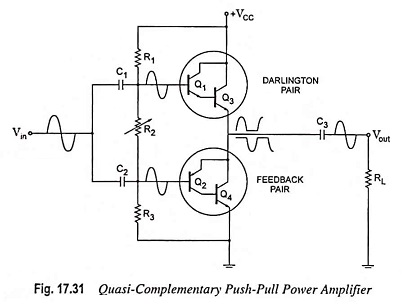Quasi Complementary Push Pull Amplifier:
In practical power amplifier circuits, it is preferable to employ NPN transistors for both high-current output devices. As the push-pull connection needs complementary devices, a PNP high power transistor is required. A practical means of having complementary operation while using the same, matched NPN transistors for the output is provided by a Quasi complementary push pull power amplifier circuit, as illustrated in Fig. 17.31.
The push-pull operation is obtained by using complementary transistors Q1 and Q2 before the matched NPN output transistors Q3 and Q4. Here transistors Q1 and Q3 form a Darlington pair that provides output from a low-impedance emitter follower. Transistors Q2 and Q4 form a feedback pair that provides a low-impedance drive to the load. Variable resistor R2 is provided for adjusting the dc bias condition so as to minimize crossover distortion. The single input signal applied to the push-pull stage provides full cycle output to the load RL.
The Quasi-complementary push pull amplifier is considered to be the most popular type of power amplifier used nowadays.
